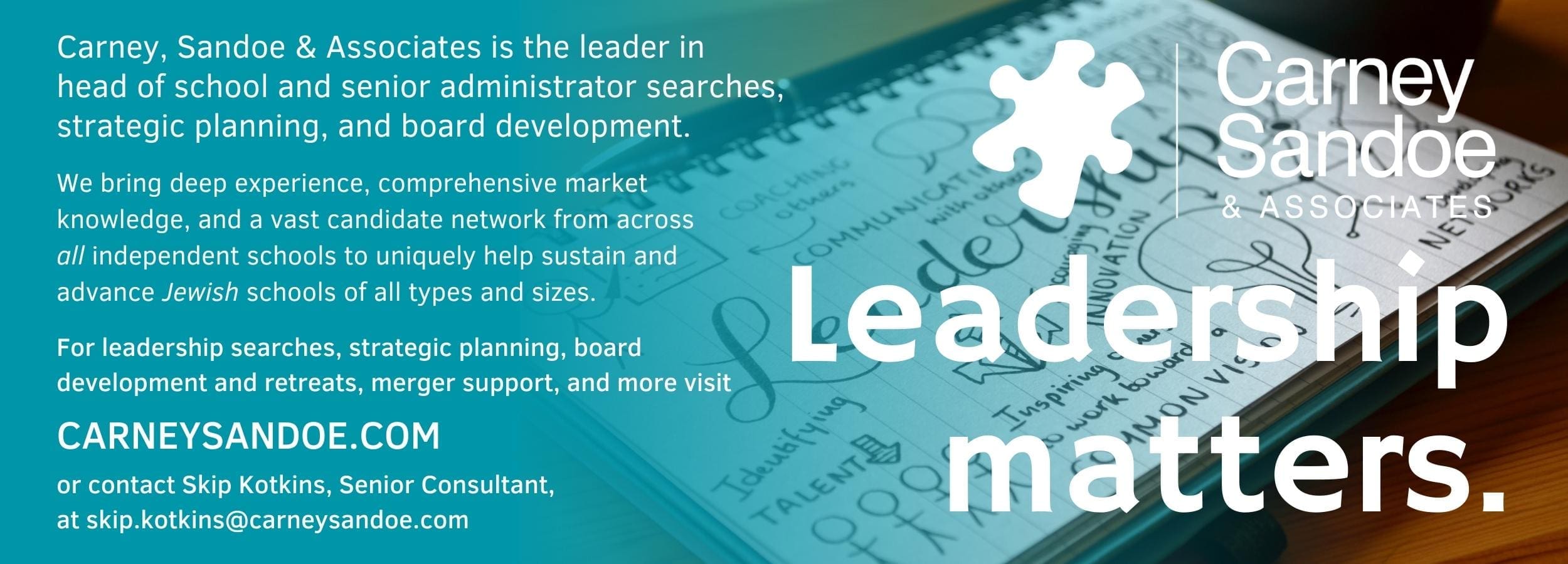Social and Emotional Supports for Educator Retention and Resilience

Nancy Parkes is an Educational Consultant and Lecturer. Much of her work is focused on helping Jewish educators and directors integrate social, emotional, and spiritual learning into their settings. Nancy received an M.A. and Ed.D. in Jewish Education at the William Davidson School of Education at JTS.



Jeffrey Kress is Provost and the Dr. Bernard Heller Professor of Jewish Education at the Jewish Theological Seminary. His latest book is Nurturing Students’ Character: Everyday Teaching Activities for Social and Emotional Learning (Routledge Press, 2020), written with Dr. Maurice Elias.
As meaningful and rewarding as a teaching career may be, it can also be very stressful and demanding. The last few years have been particularly exhausting as teachers have needed to navigate unprecedented challenges—the pandemic, political and social unrest, economic uncertainty, racism, antisemitism, and gun violence in our schools and communities—all of which affect our daily emotional state and feelings of security.
These everyday stressors affect the physical, mental, and emotional well-being of educators, leading to a variety of health and psychological issues, including burnout, dissatisfaction at work, lack of motivation, and difficulty sleeping. Teachers’ workdays have expanded with the expectation of constant contact via text, email, and social media. Likewise, the work year is often extended, with summer schedules including planning, meetings, professional development, learning new strategies, and learning initiatives that they will bring to their classrooms when the new school year begins. And, while these growth opportunities can be enriching and invigorating, they also put additional demands on teachers’ time. No wonder educators can relate to the accompanying graphic currently circulating on social media. Teacher attrition occurs for a variety of reasons, but the intensified stress of the past few years contribute significantly to the current increase.
A Concerning Cascade
As increasingly anxious youth enter our learning environments, additional challenges emerge for educators who themselves already have their coping mechanisms taxed. These teachers may find themselves struggling to find the patience and equanimity needed to successfully promote learning and positive behaviors among youth. Heightened stress can interfere with a teacher’s ability to handle challenging situations in the classroom, resulting in a classroom environment that is not conducive to optimal learning. An educator may be more apt to (mis)perceive classroom challenges as threats and to react through a lens of “fight or flight” rather than maintaining a growth-promoting stance. As the climate of the classroom deteriorates, teachers become emotionally exhausted and develop increasingly negative attitudes toward students and the teaching profession in general. These reactions result in a negative cycle: teachers have difficulty managing their own emotions, leading to a suboptimal classroom climate —misbehavior increases, teachers are less sympathetic, self-confidence and motivation decrease, and exhaustion sets in. This series of events sets up a continuous loop, referred to as the “burnout cascade.” Burnout and emotional exhaustion often result when teachers feel overwhelmed with all that they are required to do day after day.
Social and Emotional Learning for Educators
Recent attention has been drawn to emotional and mental health concerns of learners and has led to an uptick of interest in social and emotional learning (SEL). SEL helps learners develop and use the skills needed to understand and manage emotions, set and achieve positive goals, feel and show empathy for others, establish and maintain positive relationships, and make responsible decisions. Clearly, SEL is as relevant to educators as it is to students. Teachers who possess social and emotional competence report a greater sense of well-being, reduced stress, and greater job satisfaction. Additionally, socially and emotionally competent teachers are more likely to be successful in managing challenging behavior in the classroom, a major cause of teacher burnout, job dissatisfaction, and negative classroom climate.
We are not implying that those educators who experience burnout or student behavioral issues in their work “lack” social and emotional skills. Rather, the more challenging the environment, the more difficult it is for social and emotional skills to be successfully put to use. As a rough analogy, one might have the skills needed to drive a car, but finds it difficult to do so on an unfamiliar, busy street at night in the rain or snow. The “cascade” discussed above leaves many educators in a similar situation—despite their skills and best intentions, additional support is helpful to many educators in successfully navigating increasingly emotionally fraught learning environments.
For this reason, we recommend increased intentionality around SEL for educators. Self-awareness and self-management are two social and emotional competencies that can significantly influence a teacher’s ability to cope with the emotional demands of teaching. Self-awareness is the ability to identify emotions and understand how they influence one’s behavior. Self-management focuses on regulating emotions including effectively managing stress and controlling impulses, and there are a variety of tools that can help teachers learn these skills. One approach that has taken hold in educational settings is mindfulness, which many define as “the ability to respond, rather than react.”
Mindfulness helps teachers identify and understand their emotions and, as a result, empowers them to handle stressful situations using various techniques that calm the body and mind. The premise of mindfulness is to develop self-calming and awareness through a variety of activities so that teachers experience less stress, are more present for their students, and are less likely to escalate a challenging situation. These behaviors lead to classroom environments that encourage and support the emotional needs of both the teacher and their students. Additionally, by being present and exhibiting emotions and behaviors that do not exacerbate or contribute to challenging situations, teachers become powerful role models for their students.
In our own work as leaders in educational settings, we recognize that like our students, teachers bring their whole selves to the classroom. This includes all the emotions they experience before they even walk through the door and throughout any given day of teaching. As an example, one of us (NP) made teaching the skills of mindfulness, which focus on self-awareness and management, the focus of her monthly staff meetings in her congregational schools. She began by introducing teachers to various breathing techniques and meditative practices during these meetings and then offering meditation sessions prior to the start of the school day. These sessions were optional and took place for approximately 15 minutes, which included the following:
- Welcome and check in to identify and name emotions: 3 minutes
- Instruction of body positioning for breathing and meditation: 2 minutes
- Guided breathing: 3 minutes
- Set intention/kavannah for meditation: 1 minute
- 5 minutes of meditation
- 1 minute of guided breathing and reflection of intention
Teachers who attended the sessions and used the social-emotional skills they learned in the classroom, as well as in their interactions with colleagues, created a more positive classroom and work climate and perceived their work more positively. They also began to see themselves as role models for their students, demonstrating when and how to implement breathing techniques and prompting their students when to use these techniques to manage their behavior. Interestingly, there was a shift in perspective regarding classroom management. Teachers began to see classroom management as a strategy that provides students with the tools they need to manage themselves as opposed to demanding “perfect” behavior. As a result, teachers spent less time “correcting” misbehavior, which led to the building of more positive relationships and school climate. This contributed to a more positive association with learning and teaching for everyone.
We’ve both worked with students and educators who came to learn the somatic manifestations of their stress responses. What we call “feelings fingerprints” become early-warning signs for educators (and youth) for encroaching stress that may trigger negative reactions to students. We also help educators (and youth) identify “button pushers,” situations that are most likely to tax their coping resources. Identifying button-pushers and feelings fingerprints provides educators with additional prompts to take a deep breath and refocus.
Particularly in trying times such as these, educators—many of whom entered the profession out of a passion for Judaism and to have a positive impact on learners—speak about a lack of fulfillment or spiritual “nourishment” in their jobs. Even in the best of times, nurturing the growth and addressing the problems of others’ psychological, intellectual, and spiritual well-being requires emotional “labor” and can come at the cost of one’s own emotional and spiritual health. When the day is spent putting out proverbial fires, one may feel even more removed from the meaning they seek in their work. A focus on the social and emotional elements of the learning setting can be relevant here as well. SEL practices include slowing down and being present, feeling and expressing gratitude, and showing empathy and care for others. Work in these arenas can be woven into Jewish experiences in a school setting. For example, tefilla (prayer) can be a time to connect with oneself, offering opportunities to identify and acknowledge feelings, while also setting an intention of how to approach the day. This requires inter- and intra-personal skills inherent in the social and emotional competencies of self-awareness and management, social and relationship skills, and responsible decision-making. Values such as hakarat hatov (gratitude) can come to permeate a setting—with time taken at gatherings (staff meetings, assemblies) and other venues for the expression of gratitude.
We recognize that there are a variety of ways to address the stresses of being an educator (e.g., through allowing more “free periods” for planning and reflection during the day) and we do not mean to downplay those. At the same time, though, fostering the growth of educators’ own social and emotional competencies can lead to a greater sense of wellbeing, a more positive feeling about their work and their relationships with their colleagues, all of which can help create a more positive, productive working and learning environment. It becomes a win-win for everyone. So, why not begin to intentionally address the emotions of staff? Teaching and practicing social and emotional strategies to manage the stresses of our work will make us all feel better, and by doing so, will decrease burnout and emotional exhaustion and help us retain talented and new Jewish professionals.



Nancy Parkes is an Educational Consultant and Lecturer. Much of her work is focused on helping Jewish educators and directors integrate social, emotional, and spiritual learning into their settings. Nancy received an M.A. and Ed.D. in Jewish Education at the William Davidson School of Education at JTS.



Jeffrey Kress is Provost and the Dr. Bernard Heller Professor of Jewish Education at the Jewish Theological Seminary. His latest book is Nurturing Students’ Character: Everyday Teaching Activities for Social and Emotional Learning (Routledge Press, 2020), written with Dr. Maurice Elias.
Reach 10,000 Jewish educational professionals. Advertise in the upcoming issue of Jewish Educational Leadership.




